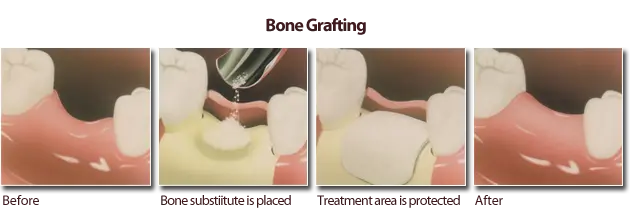What is dental bone grafting?
Dental bone grafting is a simple surgical procedure in which missing bone from within the patients’ jaw is supplemented with material from the patient’s own body or an artificial, synthetic, or natural substitute. Because the bone grafting procedure helps to replace or regrow lost bone tissue, it is also often known as Guided Tissue Regeneration (GTR).
What bone alternatives are used during the bone grafting procedure?
During a dental bone grafting procedure, one of three materials will be used to supplement the patient’s existing bone. The type of material used will depend on the size of the bone graft needed, the dentist’s advice, and the patient’s own preference. The three main types of dental bone grafts are:
- Autogenous grafts – Autogenous grafts use nonessential bone harvested from somewhere else on the patient’s own body. Dr. Doris Giraldo is able to perform the harvesting procedure and will then introduce your own bone material to the location where the bone graft is required.
- Allografts – Allografts use a portion of safe, sterilized human bone that has been harvested from a cadaver and stored in a bone bank. Cadaver bones are all screened before use and are completely sterile.
- Xenografts – Xenografts are often reserved for instances where a lot of bone material is needed to complete the graft utilizing your own bone or cadaver bone are unsuitable. Xenografts use bone from a non-human source, such as a cow. It may seem odd to think about bone from another animal being used to regenerate your own bone tissue, but it is really just a biological placeholder and is extremely safe and effective.
Although a very small procedure, some patients prefer to opt for an Allograph or Xenograft over an Autogenous graft to save them from having to have their own bone harvested.
When is a bone graft needed?
Dental bone grafting is often conducted in instances where the patient has experienced bone loss or has insufficient bone mass to support and stabilize dental implants or some other form of dental procedure such as dentures. Bone loss or insufficient bone mass can be caused by a number of things including, trauma to the bone, periodontal disease or simply a patient’s genetics, but the most common cause is atrophy as a result of tooth loss.
How can tooth loss lead to bone loss
Teeth can be easily lost throughout a person’s lifetime as a result of tooth decay, gum disease or trauma to the jaw. When a tooth is lost, the jaw bone that once supported it often begins to deteriorate quite rapidly, as it no longer has the tooth acting as a catalyst for its regeneration. Over time the jaw bone that once held the missing tooth will begin to lose bone density, ultimately disappearing altogether leaving the patient with bone loss. Once the jaw bone has deteriorated beyond a certain point, it can longer support a dental implant and therefore a dental bone graft is needed to restore the strength of the jaw before any further cosmetic dentistry procedures can be performed.
The benefits of bone grafting
Although bone grafting may sound like an intimidating procedure, it is in fact very common and can dramatically improve a patient’s quality of life, enabling them to access a far wider range of restorative dentistry procedures such as dental implants or dentures. Dental restorations can improve facial shape when cheeks appear sunken, can make it easier to enjoy food and ultimately improve the health of your mouth. So don’t let the idea of the procedure intimidate you, contact our knowledgeable dental team and let us guide you through the process.
The bone grafting procedure explained
Although bone grafting may sound quite complex, it is in fact very simple. First and foremost, your dentist will work to make the procedure as comfortable for you as possible. Our dental team will make sure that you are aware of what to expect during the procedure and keep you comfortable by ensuring that the surgical area is numbed against any pain. You will be given a local anesthetic to numb the area and a small incision will be made through the gum to allow Dr. Girlado to access the area where the bone loss has occurred. The bone grafting material will then be placed directly onto the bone loss area, under your gum tissue, after which it will be covered with a membrane to secure it in place. After a few small stitches, the procedure is complete and your bone graft will begin to heal, prompting the restoration of bone as if a tooth were once again present.
Healing after bone grafting
After the bone graft procedure, your anesthetic will be reversed and you will be allowed to go home to continue the healing process. While the procedure itself should not cause you any pain, the surgical site may become painful once the anesthetic wears off. To keep you as comfortable as possible, Dr. Giraldo will prescribe painkillers, and also antibiotics to keep the site free from infection. Depending on the size of your dental bone graft, you may need to wait a short while before having any further dental procedures conducted on the site, which will be explained to you.
Let New Dimension Dentistry and Midtown East Dentist Dr. Doris Giraldo Help
Here at New Dimension Dentistry, we pride ourselves on delivering the highest quality of dental services to our patients, whatever their dental needs. Dr. Doris Giraldo has been practicing dentistry for over 28 years and specializes in cosmetic and reconstructive procedures including dental bone grafts. So whether you’re looking to learn more about the dental bone grafting procedure, or are ready to schedule a bone grafting appointment, then contact us today!









